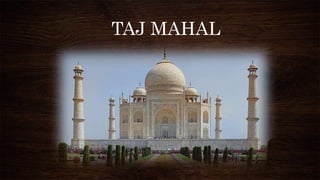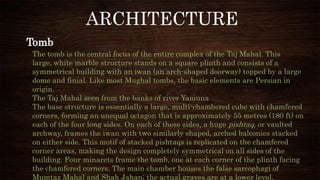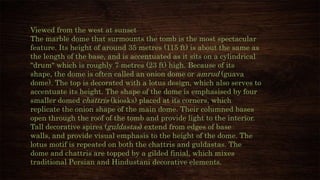The document provides a detailed account of significant historical sites in India including Fatehpur Sikri, the Taj Mahal, and Keoladeo National Park. It covers the historical significance, architectural styles, and cultural importance of these locations, highlighting their roles in Mughal history and as UNESCO World Heritage sites. Fatehpur Sikri served as Akbar's capital, the Taj Mahal is a mausoleum built in memory of Mumtaz Mahal, and Keoladeo National Park is a renowned bird sanctuary that attracts numerous migratory species.








![Jama Masjid: It is a Jami Mosque meaning the Friday Mosque
congregational mosque, and was perhaps one of the first buildings to
come up in the complex, as its epigraph gives AH 979 (A.D. 1571-72)
as the date of its completion, with a massive entrance to the
courtyard, the Buland-Darwaza added some five years later.[13] It
was built in the manner of Indian mosques, with iwans around a
central courtyard. A distinguishing feature is the row of chhatri over
the sanctuary. There are three mihrabs in each of the seven
bays, while the large central mihrab is covered by a dome, it is
decorated with white marble inlay, in geometric patterns.](https://image.slidesharecdn.com/educationaltripreport-121205015041-phpapp02/85/Educational-trip-report-9-320.jpg)










![ARCHITECTURE
Keoladeo (Bharatpur) National Park (27°10'N, 77°31'E) is a World Heritage Site
situated in eastern Rajasthan. The park is 2 kilometers (km) south-east of
Bharatpur and 50 km west of Agra. The Park is spread over approx 29 square
kilometer area. One third of the Keoladeo National Park habitat is wetland
systems with varying types of microhabitats having trees, mounds, dykes and
open water with or without submerged or emergent plants. The uplands have
grasslands (savannas) of tall species of grass together with scattered trees and
shrubs present in varying density.[4]
A similar habitat with short grasses, such as Cynodon dactylon and Dicanthium
annulatum also exists. Woodlands with thickets of huge Kadam trees
(Neolamarckia cadamba) are distributed in scattered pockets. Richness and
diversity of plant life inside the Park is remarkable. The Park’s flora consists of
379 species of flowering plants of which 96 are wetland species. The Wetland is a
part of the Indo- Gangetic Great Plains.](https://image.slidesharecdn.com/educationaltripreport-121205015041-phpapp02/85/Educational-trip-report-20-320.jpg)

